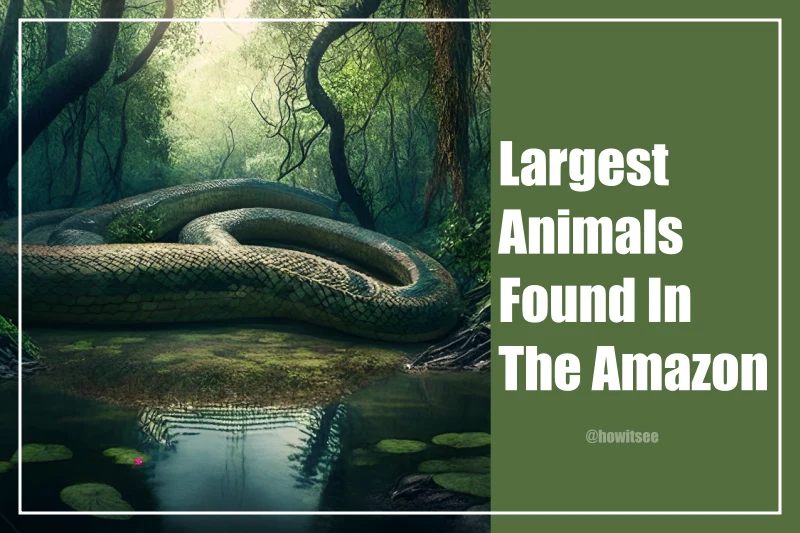Nestled within the heart of South America, the amazing world of the Amazon Forest stands as a home of many unbelievable creatures. And among these unrivaled wonders, some are even truly colossal that stand out as titans of the jungle.
In this post, get ready to meet the largest animals through the dense foliage to winding rivers of the Amazon basin. Let’s go for a job-driving adventure as we unveil the colossal creatures that rule this untamed paradise.
15 Largest Animals Found In The Amazon
1. Spectacled Bear
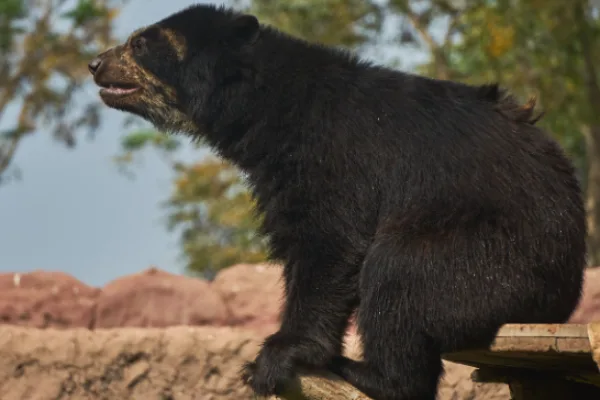
Spectacled Bear is one of the forest’s most impressive inhabitants. Despite being big, this bear has a gentle and unique personality that makes it really special.
Measuring about five to six feet long and standing at an impressive height of 2.5 to 3 feet at the shoulder, the spectacled bear is definitely not lightweight.
It weighs an impressive 220 to 440 pounds. This bear’s ability to adapt really stands out as it thrives in the challenging Amazon environment.
With its strong front limbs and sharp claws, it effortlessly climbs trees to find tasty treats like fruits, nuts, and honey.
One look at this bear, and you’ll notice its distinctive markings around the eyes that resemble a pair of spectacles. It’s these charming features that capture the hearts of nature enthusiasts and make them instantly recognizable.
2. Jaguar
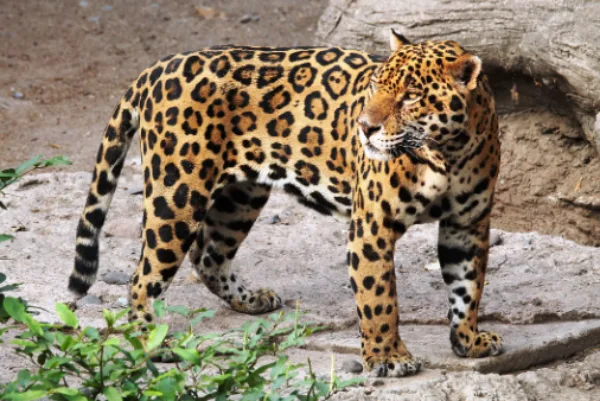
Jaguar is the largest big cat in the Americas, dwelling in the dense Amazon rainforest. It measures around 3.9 to 6.2 feet in length, excluding the tail. It also stands 2.3 feet tall at the shoulder.
Males are typically larger, weighing between 123 to 211 pounds, while females range from 79 to 141. With its muscular build and distinctive rosette-like patterns, the Jaguar effortlessly blends into the rainforest light and shadows.
Liquid with a powerful bite, the Jaguar conquers the skulls of its prey, including caimans, capybaras, and peccaries. Its exceptional vision and acute hearing, along with its agility and swimming skills, enhance its hunting prowess.
3. Amazonian Manatee
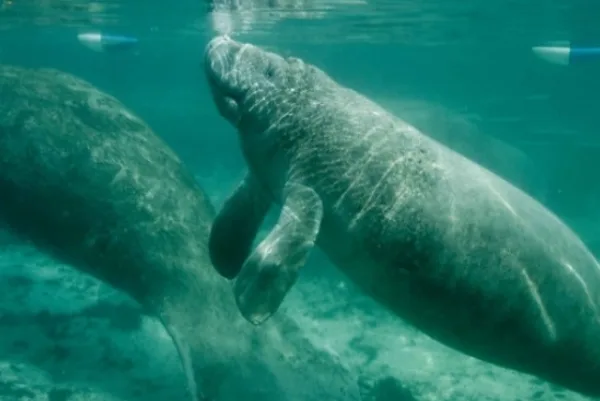
Introducing, the Amazonian Manatee, one of the true heavyweights of the aquatic realm. These remarkable beings come in truly impressive sizes. They can stretch out to lengths ranging from 8 to 10 feet, and some of them even go beyond a staggering 13 feet.
They are true giants of the water, and they can tip the scales at a hefty 800 to 1300 pounds. With their streamlined bodies adorned with paddle-like flippers and a horizontally flattened tail, these graceful creatures effortlessly glide through the Amazon’s waterways.
As herbivores, they have a hearty appetite for aquatic vegetation, devouring up to eight percent of their own body weight every single day.
However, things are really looking bad for these animals. The destruction of their habitat, accidental entanglement in fishing gear, and the menace of poaching all pose significant threats to their existence.
4. Stingray
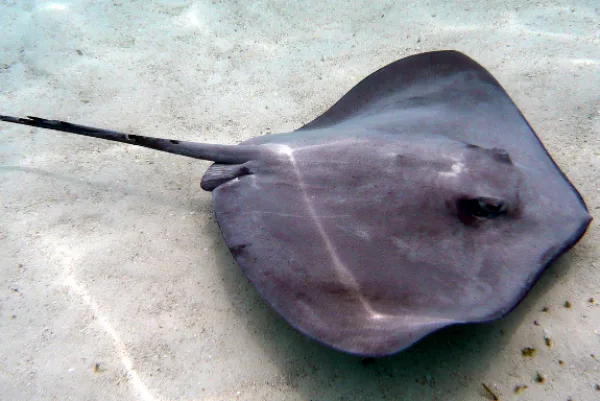
These underwater giants can grow to mind-boggling lengths. Just imagine they can stretch out to a whopping six to seven feet, and some even go beyond eight.
Picture this majestic creature gracefully gliding along the riverbed, keeping a watchful eye on its own domain. Now, get this, the wingspan of the giant stingray is something else. It can reach an incredible 14 feet.
That’s right; it’s one of the biggest freshwater fish out there. With its massive size, this stingray reigns supreme in the depths of the Amazon. But here’s the catch, encountering this majestic creature is quite a challenge.
It’s super elusive and prefers to stay hidden. Its presence serves as a reminder of the astonishing diversity and mysterious wonders that lie beneath the surface of the mighty Amazon River.
5. Giant Armadillo
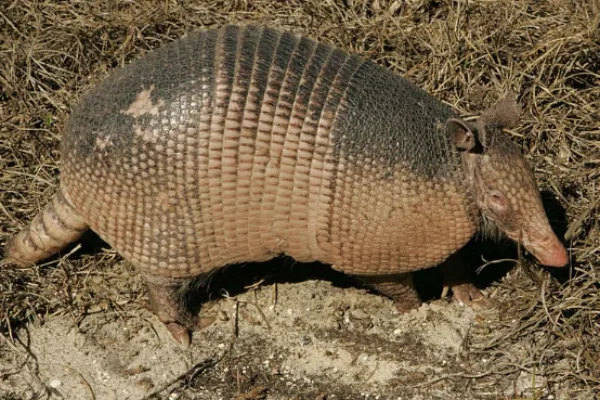
There’s one word to describe this animal: it’s definitely massive. Measuring anywhere from three to four and a half feet long, and get this, it stands about two to two and a half feet tall at the shoulder.
Just picture stumbling upon this hulking armored beast, with its tough plates shielding it from any harm. When it comes to weight, the giant armadillo does not disappoint. It tips the scales at an impressive 60 to 80 pounds, making it the biggest armadillo species on the planet.
And let’s talk about those front claws. They’re no joke. The giant armadillo uses them to dig burrows with insane efficiency. These burrows can stretch up to a whopping 23 feet long.
Not only do these burrows provide shelter for the armadillo itself, but they also become cozy homes for other forest creatures.
6. Harpy Eagle

This bird has wings that spread out to a mass of 6.5 feet. Just picture it soaring through the forest, its wings fully extended, ruling the skies like a boss.
Standing tall at about three to three and a half feet, the harpy eagle is really no joke. It’s one of the largest and most formidable birds of prey out there. And let me tell you, its size combined with its stunning appearance will leave you in awe.
Now, here’s where things get really intense. This eagle has talons that measure a whopping 5 inches long. That’s the same length as a grizzly bear’s claws.
With those impressive talons, the harpy eagle has an insane grip and strength. It can effortlessly snatch up prey, and it’s not afraid to go after monkeys, sloths, and even young deer. That’s a fierce hunter.
7. Tapir

These animals are solid and sturdy, standing at about three feet tall at the shoulder. They can stretch out to a whopping 6.5 feet long. They aren’t lightweights either, weighing in at a hefty 550 to 900 pounds.
Tapirs know how to make their presence known as they effortlessly move around their habitat. They have a pretty unique look as well. They’ve got this barrel-shaped body and a snout that’s something else.
It’s like a short trunk, which helps them reach leaves and munch on vegetation that other herbivores struggle to get to. Here’s the cool part, though.
Tapirs are like the forest’s gardeners. They shout out on fruits and then poop out the seeds intact. This helps spread the seeds around and contributes to the growth and diversity of the rainforest.
8. Capybara
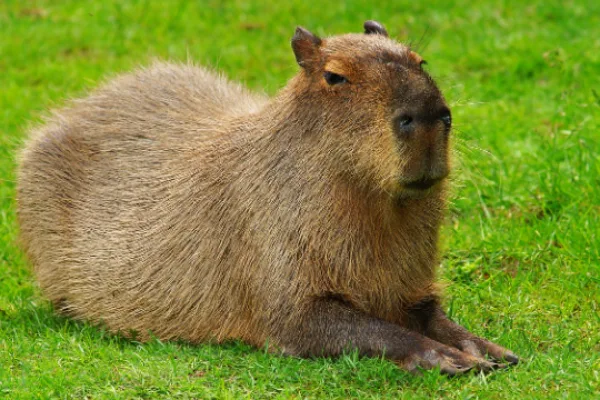
Capybaras are pretty cool creatures. They’re about 1.5 feet tall and can stretch down to around 3.5 to 4.5 feet long. And get this, they weigh a hefty 75 to 150 pounds. These creatures aren’t lightweights.
And whether they’re on land or in the water, their big size helps them move around with ease. Speaking of water, capybaras are like swimming pros.
They’ve got webbed feet and a sleek body that makes them excellent swimmers. And they spend a lot of their time in the water, diving and staying underwater for long periods.
They’re like the kings and queens of the aquatic world that aren’t fish. Capybaras are also super social. They love hanging out with each other and form groups of up to 20 individuals.
It’s like they’ve got their own little community going on. Being together helps them stay safe from predators, and they just seem to enjoy each other’s company.
9. Amazon River Dolphin

With an average length ranging from six to eight feet and weighing a remarkable 180 to 400 pounds, the Amazon River dolphin definitely qualifies as big.
These dolphins possess a sleek and streamlined body perfectly suited for life in the water. Their large dorsal fin and flexible neck enable them to navigate the intricate river system of the Amazon with everlasting grace.
Here’s an interesting tidbit: male Amazon river dolphins are generally bigger and heavier than their female counterparts. This size difference emphasizes their dominance and adds an extra touch of majestic allure to these incredible beings.
Their intelligence and adaptability are nothing short of impressive as they skillfully navigate the complex web of rivers, using echolocation to effortlessly locate prey and communicate with one another, showcasing their remarkable abilities.
Sadly, these majestic creatures face numerous threats that put their existence at risk. Habitat degradation, pollution, and accidental entanglement in fishing gear are among the challenges they confront.
10. Giant River Otter
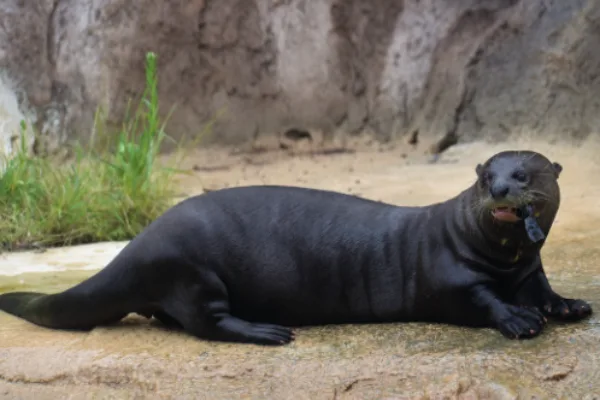
The giant river otter is a captivating creature that combines a sleek body with a playful spirit. Stretching an impressive five to six feet in length and standing around two to three feet tall, it’s a size that demands attention.
These majestic otters are renowned for their social nature, forming tight-knit family groups that can consist of up to 20 members. Together, they hunt, play, and protect their territory along the winding waterways of the Amazon.
Weighing between 30 to 50 to 70 pounds, the giant river otter holds the title for the largest otter species in the world.
With its powerful tail and webbed feet, it’s an absolute pro when it comes to swimming, gliding effortlessly through the rivers. It hunts down fish, crustaceans, and other aquatic delicacies with precision and skill.
11. Anteater
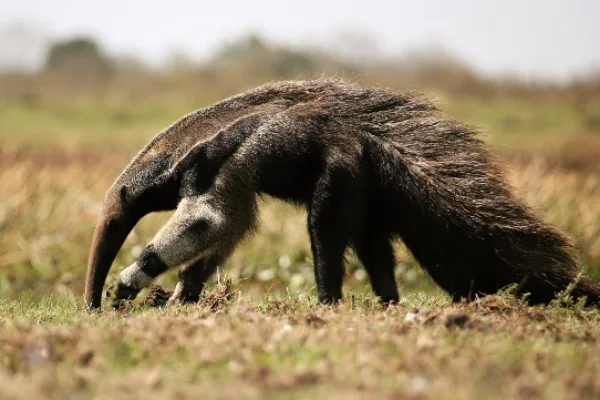
From nose to tail, the giant anteater stretches an impressive six to eight feet. Standing proudly at a shoulder height of three to four feet, this makes it one of the largest anteater species in existence.
It may have a slender frame, but the giant anteater is a powerhouse, weighing between 60 and 100 pounds. This captivating creature possesses remarkable strength and agility. With its formidable front claws, the giant anteater puts them to good use.
It effortlessly tears open termite mounds and ant hills, feasting on the insects within. Believe it or not, it can devour up to a staggering 30,000 insects in just a single day. Despite its size, the giant anteater has a gentle nature and tends to remain elusive.
Its unique adaptations, including its long snout and sticky tongue, allow it to navigate its environment with precision, making it a true marvel of the animal kingdom.
12. Green Iguana
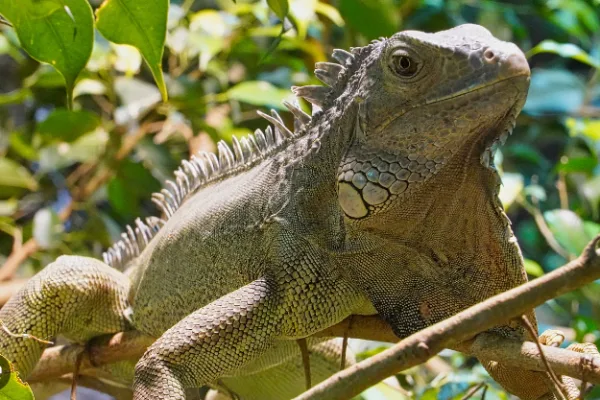
These lizards can grow up to an impressive five to six feet in length, making them the largest lizards in the region. With a body weight ranging from 10 to 15 pounds, their size is further accentuated by their long and slender tail.
This plays a dual role as a balancing tool and a defensive weapon. You’ll often find these arboreal reptiles gracefully perched in the treetops, where they spend a significant portion of their time.
Their strong limbs and sharp claws allow them to navigate their lush habitats with ease. Equipped with long toes adorned with specialized scales, they possess an exceptional grip on branches, enabling them to move with agility and precision.
What adds to the allure of the green iguana is its ability to change color, from vibrant shades of green to darker hues. These reptiles can adjust their coloration, helping them regulate their body temperature and blend seamlessly into their surroundings.
13. Amazonian Giant Centipede

With a elongated body and an array of numerous legs, this terrifying creepy crawly is the largest centipede species on our planet.
Stretching a jaw-dropping length of up to 12 inches, adorned with a segmented body displaying an intriguing range of colors from dark brown to reddish-brown, it seamlessly blends into the lush undergrowth of the dense rainforests.
Their most notable feature is the formidable pincers positioned at the front of their head, which house venomous glands that serve to immobilize their unsuspecting prey.
As skilled nocturnal hunters, the Amazonian giant centipede prowls the shadows, seeking out a variety of delicacies, including insects, spiders, small reptiles, and even tiny mammals. Utilizing their robust legs, they
And delivering a venomous bite, it swiftly subdues its victims with its substantial size and unmatched agility. It reigns as a formidable predator in the intricate web of the rainforest ecosystem.
14. Black Caiman
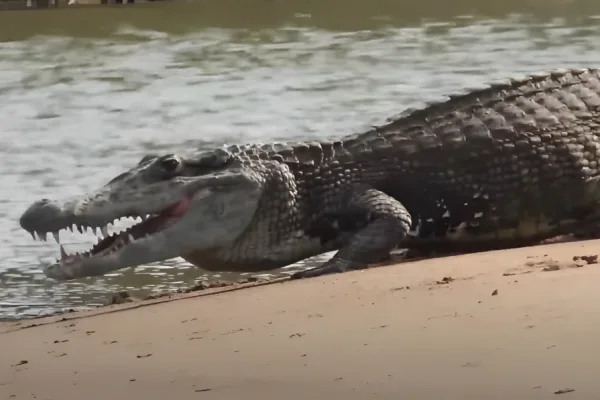
Reaching a sounding length of up to 14 feet, Black Caiman is the largest crocodilian species prowling the Amazon River.
With the robust body weighing between 600 and a thousand pounds, the black cayman exudes power and dominance in the waterways it calls home.
Its muscular tail and formidable jaws, equipped with sharp teeth, make it a fearsome predator capable of taking down a diverse range of prey. These stealthy hunters specialize in targeting fish, birds, and mammals that venture too close to the water’s edge.
With their impressive size and unrivaled strength, they execute lightning-fast ambushes, striking their unsuspecting victims with precision and efficiency. The large size of the black caiman reflects its age and wisdom.
With a lifespan exceeding 70 years, these ancient reptiles have honed their survival skills in the ever-changing rainforest ecosystem, making them formidable and enduring creatures of the Amazon.
15. Green Anaconda
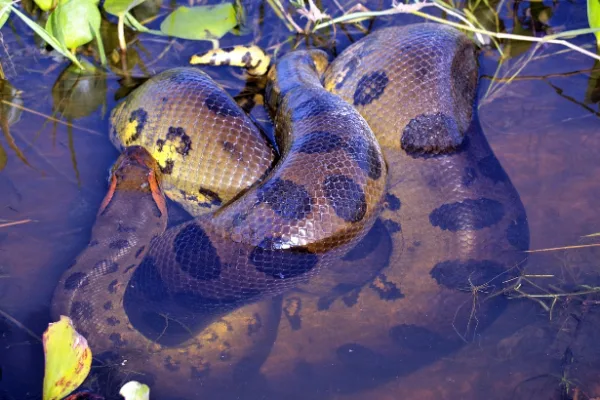
The green anaconda, with its sleek body and mesmerizing presence, is an icon of the Amazon. Reaching lengths of up to 25 feet and weighing an astonishing 500 pounds, it is the largest snake species in the world.
Its robust body, covered in beautiful green and black scales, allows it to effortlessly glide through the water with remarkable agility on land. With its muscular build and powerful jaws, the green anaconda is a master predator.
These incredible creatures are constrictors, using their powerful bodies to coil around their prey and squeeze it until it succumbs to their grip. They primarily feed on fish, birds, and mammals that venture near the water’s edge.
As we conclude our exploration, let us reflect on the importance of protecting the Amazon rainforest and its inhabitants. The preservation of this extraordinary ecosystem is not only crucial for the survival of its giants but also for the countless other species that rely on its resources.
By safeguarding the Amazon, we ensure the continued existence of these awe-inspiring creatures and contribute to the preservation of our planet’s natural heritage.
Also Read:

Meet Abhidept (nickname Monty), the visionary founder of How It See, being an engineering student, he’s fueled by an insatiable curiosity about the world around him. He is captivated by an eclectic correlation between animal groups, science, and nature, and this fascination drives his quest for understanding.
After completing his degree, he’s set on a mission to delve deep into the realm of nature, accumulating knowledge to share with you through his writing. In the meantime, he loves to watch anime and read anime.
